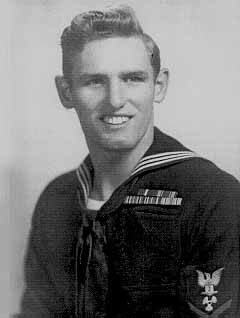HUGHES-ERNEST
ERNEST LEROY HUGHES

MM3

MM3 Ernest Leroy Hughes, USNR
Hillsboro, OR 97124-4203
Here is my story, typed by Ms Hunter-Morton, Adult Services Library, Forest Grove City Library, in Forest Grove, Oregon:
The U.S.S. Holton, D.E. 703 made its second trip with an allied convoy of about 100 vessels across the Atlantic Ocean on the way to North Africa.
We were about 400 miles west of North Africa at about 7:30 p.m. on Oct. 14, 1944. At that time on a moonless night it was pitch black, as all ships were traveling with no lights – when we were called to our battle stations by the clang-clang of the emergency bells of the Captain’s words of “All Hands man your battle stations.”
This is it- we all thought we were under attack by submarines- but as we dashed forward we could see two different volumes of flames in the distance- it was not a sub attack – but a collision. A U.S. Liberty ship the S.S. Howard L. Gibson & a British tanker the S.S. George W. McKnight.
The flames were intense & both ships had to be abandoned – we picked up quite a few we picked up quite a few sailors & other escorts picked up others – then as the ships were wallowing in the high seas, we pulled up alongside the Gibson & sprayed our five hoses on it.
A little – A large ground swell pushed the Holton against the Gibson, fouling our anchor & causing it to drop in the sea.
As the ground swells got a little smaller our Captain, John Bay pulled up on the starboard side of the Gibson & 10 of us volunteers jumped on to the Gibson. We did this two at a time because the one ship would be going on swell & the other down – if we missed the jump we would have been smashed between the two ships.
I was a fireman back home at the time & my training sure paid off. We got the water pumps on the Gibson up & running, and continued fighting the fire all night, getting it out about noon the next day.
We were brought back to our ship by “Boatswain’s Chair,” riding across the water in a little chain pulled by our crew with heavy ropes. However, half way over for some reason the crew slacked off on the rope & my feet hit the water. But that felt good, as the bottom of my shoes were burnt almost through. I didn’t know it when working the fire, but saw it later.
The Gibson lost two men, one was blown into the sea and the other I spotted burnt to a crisp as I moved up the deck putting out flames. We buried him at sea that morning – that made me grow up fast.
We saved the ship & half the cargo of crated airplanes & supplies from the bridge left. The forward part from the bridge to the bow & below deck was all burnt.
Then we escorted the Gibson to about 100 miles from Casablanca where a French Escort L’eveille (P.C. 471) took the more serious burnt crew men aboard& escorted them to a hospital in Casablanca & the Gibson to dry dock.
At full speed we caught up with the convoy but in doing so burnt out a bearing on the starboard side. It was replaced in Bizerte, Tunisia, North Africa. Then we continued on to Palermo, Sicily.
We returned to the states with a small convoy. Some repairs were made & we were given a new paint job – camouflage for the “Pacific.”
We escorted convoys all over the South Pacific, China and the Philippines seaways, then we were preparing for the invasion of Japan, forming Convoys etc. Ready to go “when the bomb” was dropped.
But we went anyway & proceeded to Tokyo Bay & protected the Battleships Missouri, Iowa, & South Dakota in case they set a trap with “frogmen” and “miniature submarines.”
We then left for Okinawa & brought dignitaries back to their homeland in Korea & China. However in Tokyo they didn’t let me go over to the Missouri to sign with MacArthur! Ha.
There are write ups in two D.E. books about the collision & fire.
- Tempest, Fire & Foe by Lewis Andrews
- Shepherds of the Sea by Robert F. Cross

